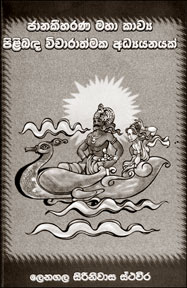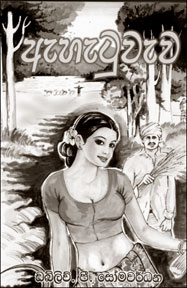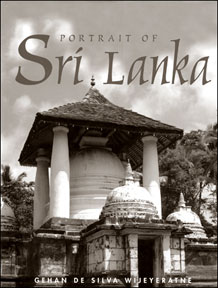|

A study of lasting value
Critical analysis of the epic Janaki Harana:
Revived by Ranga Chandrarathne
‘Janaki Harana Pilibada Vicharathmaka Adyanayak’ (A critical Study on
Janaki Harana) by Ven. Lenagala Sirinivasa Thera is a study of lasting
value as the author looks into many aspects of the Sanskrit epic Janaki
Harana by poet Kumaradasa.
 Though Janaki Harana is one of the jewels of Sanskrit literature, the
author pointed out that it is strange that a comprehensive and critical
study on Janaki Harana has, so far, not been done. The epic is made up
of 20 sections containing 1425 stanzas (Slokas) and is based on
Valmiki’s Ramayanaya. Though Janaki Harana is one of the jewels of Sanskrit literature, the
author pointed out that it is strange that a comprehensive and critical
study on Janaki Harana has, so far, not been done. The epic is made up
of 20 sections containing 1425 stanzas (Slokas) and is based on
Valmiki’s Ramayanaya.
The book grotesquely describes the rescue of Princess Sita from
Ravana following a fierce battle and taking her back to Ayondhya where
Prince Rama’s coronation ceremony was held.
The study is divided into three sections; the first chapter describes
the biography of Kumaradasa, his nationality, period in which he lived
and his myriad personality as an intellectual and the second deals with
the salient characteristics of an epic, the plot associated with Janaki
Harana, a study on the depiction of pricipal and other characters, zest,
language and style and sub-plots.In the third chapter, the author
presents an analysis on the socio-cultural backdrop against which Janaki
Harana was written.
At the end of the study the author arrives at a conclusion on the
significance of the great work in Sanskrit literature.One of the
interesting chapters in the book is the one which describes the salient
characteristics of an epic. This is of universal value as the principles
and characteristic that constitute an epic is applicable to any work of
art irrespective of time and language and the socio-economic backdrop
against which the work of art is made.
The work at hand should be neatly divided into sections and should
not contain any vulgar expressions.An epic should also be written in an
elegant style with a philosophical message in it. An epic according to
Sanskrit literature should also describethe defining moments of leaders
and contained descriptions of state visits, conference and battles. It
has also pointed out that epic should generate diverse zests.
The author concludes the work with a striking sentence describing the
epic as the only Sanskrit epic written by a Sri Lankan which is only
second to Khalidasa’s Raguwansa.
“Janaki Harana is a great work which depicts Sri Lankan as well as
Indian cultures” states Ven. Lenagala Siriniwasa Thera.
This is perhaps the most comprehensive study done on Janaki Harana, a
major work in Sanskrit literature, in Sinhala.
The author has intensively gone into the myriad aspects of Sanskrit
epic and the details of the author, his personality and knowledge
spreading into many disciplines not only shed light on the life and
times of Kumaradasa but also the rich Sanskrit literature and vast body
of works in it.
Ven. Lenagala Thera has done the critical study in a simple diction
without using didactic language and complex structures. Technical terms
in Sanskrit have always been described in simple Sinhala so as to avoid
any misunderstanding on the part of the readers.
‘Janaki Harana Pilibada Vicharathmaka Adyanayak’ is a must read for
all Sinhalese scholars and those who are engaged in production of works
of art in any medium, and would be an informative read for general
public.
‘Colombo Poet’ returns to the scene
Reviewed by J.A.J. Perera
I wonder whether I am qualified for this task of assessing a Sinhala
poetry book. I hold a doctorate not in literature but in Chemical
Engineering awarded by Martin Luther University-Halle-Wittenberg,
Germany. But I couldn’t suppress my temptation to pen these few lines on
Sundas Poetry Book named Ehetuwewa authored by Mr. W.P. Somawardana.
 Though I left my mother-country for my higher studies in the late
60s, we used to read much poetry at school, written by Colombo poets
like P.B. Alwis Perera, Meemana Premathilaka, Keyas, Kudaligama and so
on and so forth. We enjoyed their poems thoroughly. When I came back to
Sri Lanka after many years to spend my retirement peacefully, one
question always haunted in my mind, when I read present day poems. Though I left my mother-country for my higher studies in the late
60s, we used to read much poetry at school, written by Colombo poets
like P.B. Alwis Perera, Meemana Premathilaka, Keyas, Kudaligama and so
on and so forth. We enjoyed their poems thoroughly. When I came back to
Sri Lanka after many years to spend my retirement peacefully, one
question always haunted in my mind, when I read present day poems.
“Where have those Colombo Poets gone?” and I was amazed when I found
such a poet when I read Ehetuwewa which is quite a replica of those of
Colombo Poets. The booklet contains 30 poems written in such a way that
even a layman could understand and enjoy the deep meaning of the
content. I belong to that category since I was out of the country for
more than 30 years.
I had no or little opportunities to educate myself in Sinhala
literature, but I found his poems are easily understood and quite
enjoyable. His combinations of wordings are soft and very smooth and at
no instance bothered my mind.
Many feel that using high level language or wordings reflect some
one’s intellect but I believe it is not the case. What is important is
to convey the message through simple wordings and that is exactly what
Somawardana does.
By going through the poems, I realised that many are his lifetime
experiences. In many of them he had taken the shortest way to explain
his story whereas many would have taken you for a long ride and come to
the point. He is very generous in thanking all those who contributed to
expand his knowledge. I really appreciate the way he admits the
influence he received from the Colombo Poets such as ‘Keyas’ and Sri
Chandrarathna Manawasinghe.”
The book contains very beautiful and meaningful sketches too for each
and every poem. And the dates the poems were written also stated. I
noticed that in the Introduction, Professor Chandrasiri Palliyaguru,
names ‘Vevara Landey’ as one of the poems he admires much. The reader
can excuse Somawardana for writing such a romantic poem not now,but at
his prime youth as revealed by the date on which it was written.
It seems that Somwardana has started his career as a teacher. His
first posting was at Ehetuwewa the name of the book and in it, I read
with interest his 3 months stay. His explanations are such that you
could visualize the school, surrounding, nearby village and the
activities of its people.
He also writes about his departure well in Samu Ganeema. I found his
Sinhala Avurudda very delicately written where we could visualize the
experience we had in the 70s in Sri Lanka.I particularly liked Poojawa
and felt that he could have built it up to a long story. Some other
interesting poems are Dadayame Giya Samiyata, ‘Ahimi Vu Surathe
Kathawasthuwa’ and the translation to Robert Frost’s poem. In general,
all these poems dealt with some romantic topics and explanations and
their meanings could easily be understood.
Sri Lanka in pictures
 by Nilma Dole by Nilma Dole
In an attempt to highlight the best aspects of Sri Lanka and the
glory that it has to offer, the New Holland publishing company has
released a pictorial creative collection of the wonders of Paradise
Isle. Enlisting the services of photographer Gehan De Silva Wijeyeratne,
the journey around Sri Lanka transports us from the ancient ruins of
Anuradhapura to the green foliage of Sinharaja forest and everything in
between.
It is a collector’s item for it gives the curious traveller hidden
treasures that will stun anyone who isn’t familiar with the Pearl of the
Indian Ocean. The delightful images are organised in an easy and
comprehensive manner with sections labelled ‘The West’, ‘North of
Colombo’, ‘North Central Province’, ‘Central Hills’, ‘Highlands’ and
‘The South’. This book gives an insight as to where travellers should
go.
New Holland’s goal is to accelerate the development of tourism in Sri
Lanka as a destination, which goes beyond beaches because of a diverse
culture and breath-taking biodiversity. ‘The Portrait of Sri Lanka’ will
help position Sri Lanka as a must-see destination with vast ancient
metropolises, big game and beautiful scenery.
Once upon a time....
Though with advancing age we realise that the incidents we come
across in fairy tales are far from reality, even as adults we would love
to return to the same stories as they are fantastic stories of which we
never tire. The memory of fairy tales always takes us back to our past
when we fully believed in what we read!
Fairy tales are clearly a distinct genre. Amidst more influential
genres of literature such as novels, poems, or short stories, fairy
tales have always been able to retain their celebrity status throughout
the centuries. They however did not have a ‘fairy tale’ beginning,
though today we always use the term to connote something blessed with
unusual happiness.
Way back in history the term “fairy tale” was ascribed to them by
Madame d’Aulnoy.Ironically the nature of a tale does not depend on
whether fairies appear in it. As English novelist and journalist Angela
Carter in her introduction to Virago Book of Fairy Tales mentions that
many of the famous fairy tales do not depict fairies at all.
Fairy tales have been classified in various ways, the most
significant classifications being the Aarne-Thompson classification
system and the morphological analysis of Vladimir Propp. Prop had always
been critical of the common distinction between fairy tales and animal
tales in his “Morphology of Folktale”.
As he says many tales contained fantastic elements as well as
animals. The oldest known written fairy tales are said to be from
ancient Egypt. Today, fairy tales is a popular genre in written
literature throughout the literate cultures.
It is in fairy tales that we come across fairies, goblins, elves,
trolls, witches, giants and talking animals, but we never question their
presence. Historical time is immaterial in fairy tales- they are not of
a place, not of a time , but “once upon a time “ and would never become
‘stale’! They always have a happy ending as almost everything turns out
for the best for the hero or heroine.
Two theories of their origin have attempted to explain the common
principles in fairy tales that are popular around the world. One theory
is that a single point of origin generated any given fairy tale, which
then became popular around the world. Next is that common human
experience provide the themes for these tales, so that they can appear
separately in many different origins. It was only in the 19th and 20th
centuries that the fairy tale came to be associated with children’s
literature. At the beginning, they were meant for adults as well.
Almost all the fairy tales give us a moral in the end.The moral
“Cindrella” leaves is that beauty is a treasure, but graciousness is
invaluable. A person can achieve anything if he/she is blessed with
that. Without graciousness, nothing is possible! “Beauty and the Beast”
shows us that true love can do miracles! The prince who was turned into
a hideous beast by a fairy to take revenge as he refused to let her in
from the rain, could break the curse only by finding true love.
Throughout centuries fairy tales like Little Red Riding Hood,The
Bear, Hansel and Gretel, Snow White, The Pied Piper of Hamelin, The
White Dove, The Blue Bird, Ali Baba and the Forty Thieves, The Golden
Bracelet have been entertaining children across the world. Gender, race,
caste or class were never an obstacle to enjoy them. One major reason
for the undiminished fame could probably be that it is only in fairy
tales that virtues are ‘definitely’ rewarded.
-Samangie
Teen author Lishan, a guest speaker at the World Book Fair
Teenage author Lishan Perera was invited as a guest speaker at the
World Book Fair 2008 which was held in Singapore recently. His debut
novel was ‘The Killer’ (2006). He is also the author of ‘Time to Die’
and ‘Pure Evil’. His short story “In the Hands of Fate” was selected to
be published in a Daily News anthology. Lishan’s novels are available in
number of countries such as Singapore, Malaysia, Hong Kong, Vietnam and
Indonesia. |
